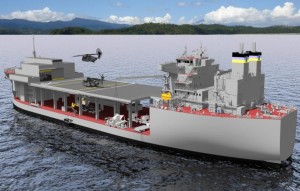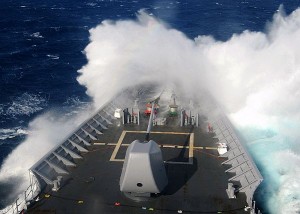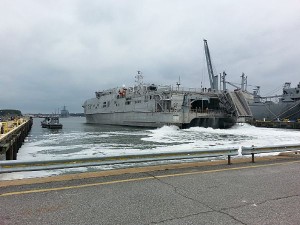 By now it should be pretty obvious that the post-Cold War U.S. Navy forgot about high-Sea-State operations…and somehow decided to harness the Navy’s future to a foolish idea that Sea State 3 was a fine operational goal for critical shipboard systems.
By now it should be pretty obvious that the post-Cold War U.S. Navy forgot about high-Sea-State operations…and somehow decided to harness the Navy’s future to a foolish idea that Sea State 3 was a fine operational goal for critical shipboard systems.
It made sense. Life was good back in the Post Cold War era–The Navy was counter-insurgency focused, hunting pirates or bombing terrorists and nobody expected a need to go spend any more time in the North Sea going toe-t0-toe with the Ruskies, China was “decades” away from even modest carrier operations and real-time forecasts from America’s incredible weather-prediction infrastructure was expected to allow even the weakest ships to avoid higher Sea States. Engineering for higher Sea States was costly, too, and shipbuilding money was in short supply.
But things have changed. And now that the Navy has gone and procured several platforms with significant operational limitations beyond, essentially, Sea State 2, naval operators are belatedly rediscovering that they are going to need to spend time in Big Oceans that have Big Seas. They are also discovering that over-engineered, artisanal systems that bend and break in mid-Sea State 3 are, well, pretty much useless out there.
This inexplicable acceptance of low Sea State performance is quite serious–virtually all the sea-basing platforms (and some others) are facing Sea State challenges at the critical subsystem level or–worse–in the fundamental structure/design of the hull. But again and again, Sea State seems to have been de-emphasized in favor of meeting other requirements.
 Navy Should Have Known Better
Navy Should Have Known Better
The Navy knows (or at least knew, once) better than to skimp on Sea State. In 1982, the Naval Sea Systems Command published an Association of Scientists and Engineers Technical Symposium entitled “Designing Ships to the Natural Environment.” That report–which grew out of concerns that Russian ships were better designed to handle rough seas–was one of the first out there to try and model Sea State to ship effectiveness and to estimate/model the average Sea States the Navy would experience in different regions.
What did the Navy researchers predict? Well, they estimated that seas would exceed Sea State 3 about sixty percent of the time. And now that the Navy is struggling to field a bunch of Sea State-limited sea-basing platforms in places like the Pacific and the Northern Atlantic, they are discovering that this old and dusty model has held up pretty well.
On the flip side, the Navy models suggested the seas would stay below Sea State 5 about 80 percent of the time (and stay below Sea State 4 about 60 percent of the time as well). And that result helped lead strategic grey-beards waaay back in 2004-5 to caution bright-eyed technologists that Sea State 4 operating capability was still a much-needed thing.
But somehow, in the Navy’s infinite wisdom, strong and justified “through Sea State Four” objectives were diluted into a muddy “through Sea State Two and BARLEY into Sea State Three” reality.
Operations are suffering for the Navy’s failure to commit to the original sea state operational requirements.
With virtually all of these Sea-State limited systems, the writing has long been on the wall. And nobody has said anything. All while NAVSEA was out there busting their butts to get something to operate once or twice in seas juuuust barely at sea state three (It worked! Once! YAY we passed DOT&E scrutiny! Hooray! Alert the Admirals! Beers for everybody!), operational commanders should have been raising an enormous stink about the decaying Sea State requirements. At a minimum, they should have gotten about the business of adjusting their strategies and tactics to reflect operational realities. As far as sea-basing goes. it was pretty obvious to even casual observers America was not building a sea-base, but building something to serve as a degraded harbor-base or maybe (maybe!) a lagoon-base. JLOTS Redux.
Nobody–not even a rocket scientist–can kludge Sea State 4 capability onto a Sea State 2 hull. And the Army and Marine Corps had best recognize this fact, fix it, or get around to adjusting their doctrine and strategies accordingly.
 It’s Not Rocket Science
It’s Not Rocket Science
The Navy’s fundamental engineering approach for systems that are Sea-State dependent seems wrong. The priorities are backward. For example, the Navy has known for decades that ramp-based ship-to-ship interfaces were a challenge. The Navy has also known the technology to manage those interfaces was not ready. But rather than focus on the Sea State challenge and build really robust sea-basing ramps that reliably function through Sea State 4–and probably forcing the Marines to work around some (likely substantial) initial weight limitations, the designers focused on meeting USMC weight tolerance requirements. So now, sea-basing ships have gotten these giant ramps that were built to accept the largest gear in the ground warfare arsenal. As far as Sea State goes, the Navy has gotten a whole bunch of promises, that, somehow, the ramps will somehow “work” well enough to handle high Sea-State sea-basing. The same mistakes have been made for vessel recovery systems, flight decks and other systems.
So now-again and again and again–naval engineers are not only being forced to handle the daunting technical challenge of managing ship-to-ship interfaces/boat recovery schemes/other critical systems at high Sea States, they’re being forced to try and find incremental solutions for super-sized, already installed interfaces, where the weights and forces are often enormous.
That’s not a recipe for engineering success.
Build to Sea-State first, and then scale up.
I mean, look, there’s no argument with the sea; if Sea States exceed operational imitations, the mission–be it operational support for sea-basing, flight deck operations, boat/system launch and recovery or anything else–won’t get done. The consequences are brutal; the ship will break, lives will be endangered, the civilian master will risk their license and livelihood every time the Navy tries to operate “beyond the envelope”…and so on.
Even worse, a vessel’s Sea State limitations may prove permanent as Sea State limitations are mind-bogglingly difficult to remedy. Once “lowest cost driven” performance limitations are baked into a platform in the form of a crane or flight deck or launch/recovery system, Sea State fixes are, at best, extremely costly. And even in the rare cases where cost is no object, the necessary fixes are often a physical impossibility–the crane/ramp/protective equipment/ride systems are too heavy/big to simply back-fit into the platforms in question. Sea State operational requirements quickly become untenable.
Once the engineering solutions are methodically nixed, the only acceptable solution is to change the mission (and then fund an appropriate R&D and prototyping effort). So…I suspect the Navy had best prepare to come to terms with a big shift in many a platform’s CONOPS. For many of these critical systems out there, there’s no other route left than to essentially ramp down operational expectations. Which means–for example–that Sea-Basing advocates had better dust off all those old JLOTS tactics, because Sea-Basing, in it’s current form and with it’s current vessel-mix is gonna become little more than JLOTS.

{ 5 comments… read them below or add one }
There are alternatives that can be developed. Recently a lot of work has been put into developing stable platforms for commercial use, most of these being born from military vessels, ie SWATHs, and SES vessels.
Suspended hulls less so, but it is only a matter of time until this technology is incorporated into boat design in one form or another. In addition the use of USVs is also growing and this is another obvious growth area.
Nice article Craig.
It is also true of the UK Navy and no doubt others in the EU too. I think one hidden factor in all this is the obvious elephant in the room. Money!
When commercial companies, no longer Govt owned and run shipyards, make offerings of moon dust to Govt Navies of stealer performance and at significant cost savings – all via a very fancy presentation with someone who was born with verbal diarrhea – all that is remembered is the SAVINGS. And then confirmed by the graph of stealer performance figures.
Let’s face it, all commercial yards are there ostensibly to make a buck. Thus their bottom line is to make money and making money means the art of selling ones product. I’m not suggesting that the products are bad, but, their raison d’etre is not long term customer support – but to get a contract to keep the yard employed. That’s it.
As such the designs offered are more “commercially” minded. That means being as light and cheap and easy to build as possible = making money for the yard! Their model is driven by the need to make money and keep shareholders (if public) happy.
Whereas in the “old” days, the designs went about a rigours review without any major financial input. The design that was selected was the ‘best’ for the job at hand and then sent to yards for prices: at the Govt owned yards.
In this, the and age of instant electronic spreadsheets, of costings and man hours and procurement, this has watered down the design driven model, into a financial driven model.
Design driven models work, because money is not the prime input. Success and effectiveness of the design is.
Thus I surmise that one of the principal causes is the lack of Govt owned yards and independent Govt owned design centres and the dept to make decisions based upon design criteria and not financial spreadsheets.
Because a SS4 is only Hs= 1.25-2.50m…it isn’t much. It is not difficult to design ‘models’ that can work in this environment, and as you note, once said limitations (for the quid pro quo) are taken into account, no one complains anymore! It does what is says on the tin!!
I can’t disagree with you. But is it possible that what is happening is the symptom of a much larger problem? Is asking a supply ship to do something it shouldn’t any different from asking a warship or warrior to do the same?
By fixing the engineering problem are we going to find out that the fix is just as dangerous? My experience in the Navy indicated that much of the time that is true. Often the cause that required the engineering fix also limits the need to be doing the act in the first place.
Or to put it another way, after all the engineering, “Is the juice worth the squeeze?”. So is using the ESB always bad? Of course not. Chasing pirates with an ESB as a mothership concept is perfect. Saves money and gets the job done. If the weather and sea state is so bad that I can’t do my job with the ESB, then the very victims the pirates want will be leaving and the pirates in little boats will certainly not be at sea anyway.
Don’t get me wrong, I’m not suggesting that the ESB in my example should be used, say in the North sea to extend the ASW mission. That’s not a good idea. But then that leads into the idea that sea state 3 or 4 in the North Sea, Aleutian Islands or around Drake’s Passage is not the same as the middle of the ocean. That bathtub effect is almost always worse than running into the wind/waves of a storm in the Pacific. Again, that ends up very often, the ends and means don’t really match either way. The answer is, don’t do that. Then we would get into the flexibility needed during war during those few times that doing it another way is needed.
BTW: The Soviets made a machismo thing out of doing things we couldn’t. They also suffered losses for it that, had we gone to war would over time been a reason they lost the war sooner.
Hi Bryan–
Yeah, I agree that we tend to ask platforms to do far more than they probably should, and that there is always a tradeoff somewhere when you ask for additional capabilities or capacities.
But I think what I am getting at is the way we’ve gone about making some of the tradeoffs. I don’t know if it’s just some sort of “checking-the-box” requirements chasing (sort of how Medicare billing jockeys game ICD-9 codes), but it feels to me that we’re not prioritizing the right requirements and ultimately end up putting a lot of nice-looking lipstick on pig-like systems.
I’m not necessarily attacking the ESB either. But it grew out of a strategic system that walked away from some justified–and frankly a relatively common sense set of sea state requirements, and that worries me. My sense is that we’d end up really liking operational capability through sea state 3 and well into sea state four. If we don’t have it, I think it is important to ask why and to conduct an analysis of alternatives that focus on employing a different hull design.
But, that said, I agree with you. We ask our ships to do a lot, and often we are justified to do so. Would I rather have more? You bet! But without more ships, we need to be smart in designing the ships we do have. Part of being smart is in walking away from requirements sets that are near-impossible to meet.
I don’t think we disagree at all. At least not about the problem. These systems are complex and the solutions mostly defy a binary answer. When we look at individual examples as you used with the ESB we certainly can come to an answer the will fix the problem. My idea isn’t to disagree with that but to suggest that the ultimate cause of that problem is systemic and can’t be fixed with engineering or even money.
So using a system outside it’s parameters will eventually cause damage and even loss of life. Upping the parameters just makes the management of the Navy ask for more thus exceeding the new parameters. So the true problem isn’t that we can’t off load items but that we’ve made a plan that, “only” works if we use the system outside it’s parameters. That fault is Navy-wide. They do it on purpose and then ask for more money. It’s a management problem for every system.
The, “fix” for that problem is to remake the Navy culture. To break it from the current cycle of boom and bust. The cycle that builds and then hollows out during every recession. To force it to be more resilient.
Does the Navy have enough hulls already? Probably. It just uses the vast majority to protect carriers. Then the Navy will explain that the carriers project power. They say this with a straight face. Did they project power all the times that Bear flew over the top of it. The bomber was on top of us long before we noticed and called an alert. Did it project power when the Kitty Hawk ran over the top of the Soviet sub, clipping it’s tail? Did it project power when our allies pop their sub inside our battle group as a publicity stunt? Does it project power when China is violating international law in the SCS? No to all of them. Like the sub, the carrier is a great tool for war and hostilities. It’s just a sitting duck the first day of war. It just sucks at power projection.
The Navy doesn’t have a hull problem. It has a management problem. It has a strategic problem. The best way to fix all these problems is, “To give it more money?” I don’t think so. The truth is to freeze the budget for the Navy. For ten years make them do more with less. Order them to remake the fleet where the light destroyer is the power projection tool. Where the SAG is king. Where the carrier is who shows up later as back up. That will be a good start.